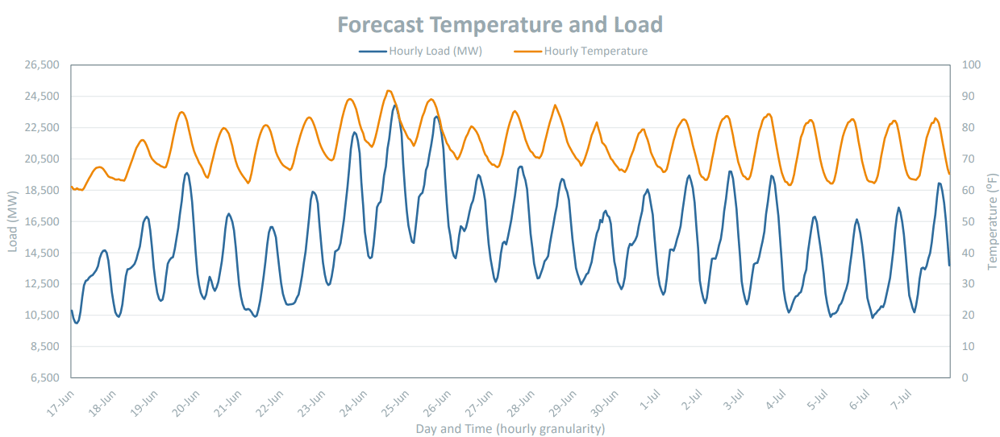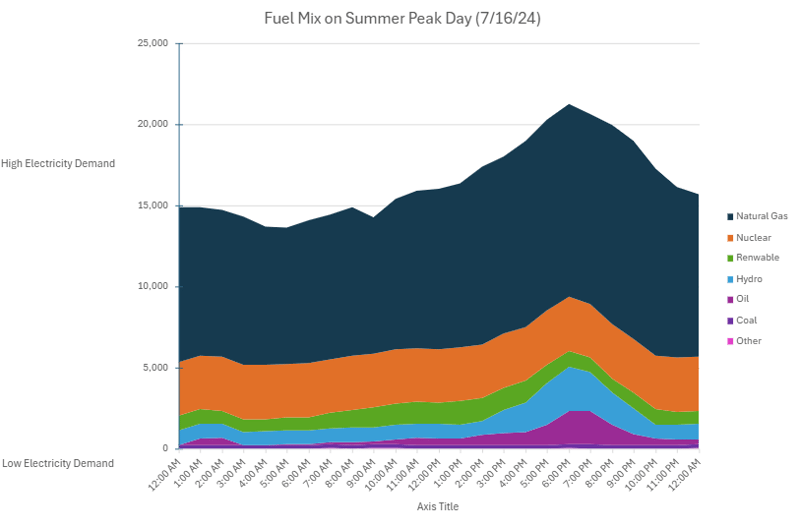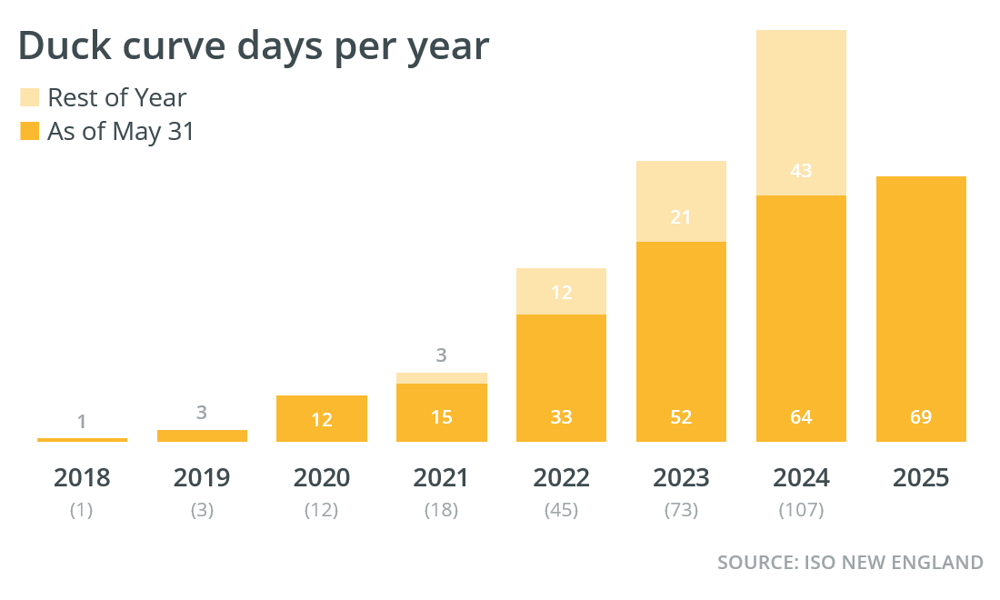As summer approaches, thousands of our followers prepare to “Shave the Peak.”
Shave the Peak is our program designed to inform people, via text and email alerts, how and when to reduce power use on days when electricity demand is significantly higher than usual. As we begin to see temperatures rise above 90°F this summer, skyrocketing demand on the power grid leads to an increase in fossil fuel consumption and wholesale prices (which ultimately get passed onto retail customers – us).
The New England power system often sees demand peaking just as solar power production tails off at dusk, and it’s still hot. “Peaks” on a given summer day refers to the hour when demand was highest (for example, 6 PM). Shave the Peak alerts often recommend saving energy during a specific timeframe, usually 4–8 PM, depending on the day’s specific conditions. The 6–8 PM period is typically the highest peak.
Peak days are a major factor regarding pollution and the cost of our electricity.
Shave the Peak Alerts
This summer, subscribers to Shave the Peak will receive text and email alerts on peak days with information on individual actions that can help reduce overall electricity usage during peak demand hours. If you’re subscribed (it’s free), you will receive an alert the day before and the day of a potential peak.
How do we determine when to send peak alerts? We will be watching the weather forecasts and electricity demand forecasts from ISO-New England, the non-profit Independent System Operator with a responsibility to maintain reliable electricity to the six New England states. (You can track this data through the informative and user-friendly ISO-to-go app.) On the occasions when New England’s demand is expected to rise over approximately 22,000 MW, we will see that as a time to communicate with subscribers. If we see that we’re in for a heat wave of a few days, we won’t text you every day.
Yes, it’s the air conditioning.
The graph below from ISO-NE is from a 21-day hourly load forecast between June 17, 2025 – July 7, 2025. The blue line represents the hourly load (energy usage measured in megawatt hours) forecast and the orange line represents the temperature. The chart shows how as summer temperatures begin to rise, the peak demand rises in correlation with it. While the average household might use about 600 kilowatt hours per month over the entire year, usage rises significantly in the summer. You can also see how demand ebbs and flows each day.
Note that the highest peak forecast is June 24!

Peaker Plants & Environmental Justice
To fill the increased electric demand on peak days, the grid must turn on peaker power plants. Peaker power plants are often old, dirty, and incredibly expensive to operate. They run primarily on natural gas and oil. Shaving the peak, therefore, means reducing the amount of fossil fuels emitted.
Peaker plants are a driver of local air pollution, releasing not only greenhouse gases but also pollutants like sulfur dioxide that gravely harm our lungs and tend to disproportionately affect low-income and minority populations.
If we can reduce peak demand by shaving the peak (and other methods of grid modernization), these dangerous, dirty peaker plants will no longer need to be kept online.
The Applied Economics Clinic is doing good work figuring out ways to reduce our dependence on peaker plants. Here and here.
This graph shows you how New England tends to meet demand on a peak day. The data is from July 16, 2024. As you can see, the bulge in demand was mainly met by natural gas (black). But oil came into play around 6 PM. This is what we are trying to avoid!

Behold the Duck Curve
 Pollution and costs would be much higher in New England if we didn’t have so much “behind-the-meter” (mostly rooftop) solar. Every kilowatt of solar that is produced on homes and businesses reduces the amount of fossil fuels we need. And to state the incredibly obvious, there is a nice correlation between sun and heat.
Pollution and costs would be much higher in New England if we didn’t have so much “behind-the-meter” (mostly rooftop) solar. Every kilowatt of solar that is produced on homes and businesses reduces the amount of fossil fuels we need. And to state the incredibly obvious, there is a nice correlation between sun and heat.
Nearly half of all days so far in 2025 have seen lower demand for grid electricity during daylight hours rather than overnight—a sign of the increasing impact of behind-the-meter solar power. When there’s a pronounced drop in demand for grid electricity in the middle of the day, the line somewhat resembles the profile of a... you guessed it.
A more technical depiction is shown below. The beige color at the top shows how demand for grid power would have looked if it were not for the behind-the-meter solar.

The cool thing (pun intended) is that we get more duck curves each year as we add more solar.

Also according to ISO-NE, at the end of 2024, the region had 4,542 megawatts (MW) of installed BTM PV capacity. That is expected to more than double over the next 20 years, rising to 11,156 MW in 2045. In summer 2024, BTM PV reduced the peak by an estimated 1,520 MW, or about 6%. The forecast summer peak reduction from BTM PV remains roughly at that level for the next 10 years, declining slightly thereafter, as the anticipated effects of electrified vehicles pushes summer peaks to nighttime (Green Energy Consumers would note that robust managed charging programs for EVs would do a lot to shave the peaks in future years – it’s very easy to schedule EV charging). The winter 2024/2025 peak saw no impact from BTM PV. However, BTM PV is expected to have a modest impact as winter peaks shift toward morning in the 2030s.
For more information on the New England Duck Curve, visit ISO-NE.
How to Shave the Peak
If you are enrolled in our Shave the Peak program, we will text you a friendly reminder to do what you can to curtail energy consumption during peak hours, The highest peak on a sunny day might be about 6–8 PM, because, as shown above, we have a lot of solar on the grid nowadays which reduces the need for fossil fuels in the earlier hours, but our participants try to keep electricity use low before and after the highest peak, just in case.
Typically, if we receive information that the peak will occur on one particular day or two, we let participants know via text, email, and social media.
Here are practical ways to "shave the peak" during those specific hours:
- Pre-cooling works! Focus your AC usage on a couple of rooms, and get them nice and cool before 5 PM. Then, turn the AC up a few degrees, or turn it off if you can handle it.
- Use fans wherever possible to compensate for AC, and draw the blinds to help keep rooms cool. If you're planning an outing to the pool or to the air-conditioned library or mall, do it during peak hours!
- Don’t do the laundry. When you do, wash in cold water.
- Don’t run the dishwasher.
- If you have an electric car, schedule your charging session for 9 PM to 7 AM. Avoid peak times!
- Sign up for Shave the Peak to get reminders to reduce your electricity use when it matters most.
Note: Our air would be cleaner and we would be paying a lot less for power if we shifted power use to off-peak hours on a year-round basis, but it’s especially important when the weather is this hot.
Ask about Connected Solutions.
Connected Solutions is a demand response program offered in several Northeast states, including Massachusetts, Rhode Island, and New York, that incentivizes homeowners and businesses to reduce energy consumption during peak demand periods. Participants can earn rewards by allowing their smart thermostats or battery storage systems to temporarily adjust energy usage during peak times, helping to stabilize the electric grid and reduce carbon emissions. For information, contact your local utility: Eversource, National Grid, Unitil, and Rhode Island Energy
The Future of Peak Shaving
Very briefly, but within a few years, peak shaving should evolve into something bigger and better. Utilities in Massachusetts and Rhode Island are beginning to install “smart meters” that will enable the implementation of more robust programs than what Connected Solutions is all about. We can expect to see time-varying rates and more load management programs to incentivize efficient energy use. The idea is to shift financial rewards away from peaker plants to participating consumers in ways that will benefit ALL consumers by driving down the system-wide costs that we all pay for. We will keep you posted!


 Pollution and costs would be much higher in New England if we didn’t have so much “behind-the-meter” (mostly rooftop) solar. Every kilowatt of solar that is produced on homes and businesses reduces the amount of fossil fuels we need. And to state the incredibly obvious, there is a nice correlation between sun and heat.
Pollution and costs would be much higher in New England if we didn’t have so much “behind-the-meter” (mostly rooftop) solar. Every kilowatt of solar that is produced on homes and businesses reduces the amount of fossil fuels we need. And to state the incredibly obvious, there is a nice correlation between sun and heat.

Comments